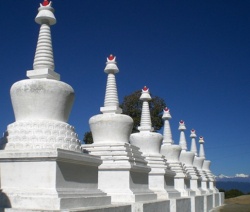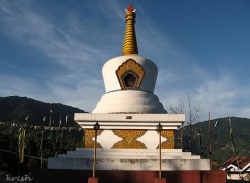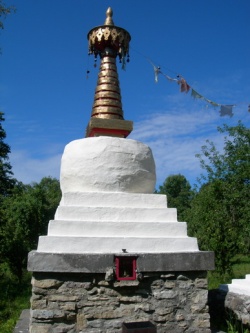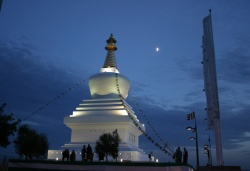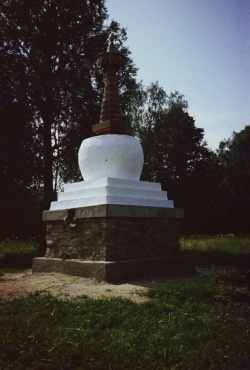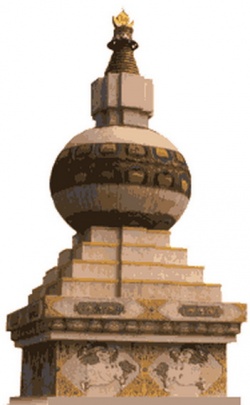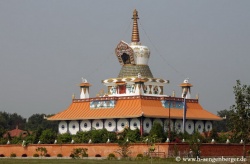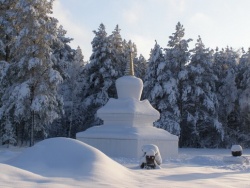Symbolism of the Stupa?
In pre-Buddhist India, grave-mounds (tumuli) of ascetic saints were regarded as holy place for pilgrimages and places of meditation. Their shape – that of a dome – was the beginning of the Buddhist Stupas.
The dome shape originated form the seated position the saints were buried in. Now the shape represents the proportions of the Buddha’s body. The stupas shape is said to be that of the Buddha seated for meditation.
The Buddha Shakyamuni had ordered his disciple to place his ashes in a monument, or stupa, as was the tradition of Indian leaders of the time. However, instead of doing this for later generations to worship him, he did it to encourage and inspire others to free themselves from suffering. Thus, the Stupa became not only architecturally important, but also spiritually important.
When the Buddha died, the question arose of who his remains would belong to and therefore, who would be the builder of such a great monument. As no one could decide the answer, his remains were divided among eight kingdoms. With eight different stupas being built, it is easy to understand that none of the designs would be the same. Therefore, these eight designs are symbolic of the eight major events in the Buddha’s life. These events are:
1.birth
2.enlightenment
3.the turning of the Dharma Wheel
4.descent from a heavenly realm
5.performing miracles
6.reconciling a split in the Sangha at Bamboo Grove
7.voluntarily prolonging his life at Vaishali, and
8.his death at Kushinagar
The eight stupas are also symbolic of the eight – fold path to enlightenment. The components of this are right view, right thinking, right speech, right action, right livelihood, right diligence, right mindfulness, and right concentration.
The Stupas are also symbolic architecturally. There are five geometric shapes of the Stupas that corrspond to the five elements (void, or space, being the fifth):
1.A square base or foundation corresponding to earth.
2.A dome, or and a, corresponding ro water.
3.The harmika, in the shape of a stone fence, corresponding to fire.
4.The pole of the umbrella or parasol, corresponding to air or wind, and
5.The umbrella itself, corresponding to the void, or space.
There are, however, more than five parts to the stupa. The base has four steps, there is a gate and fences, and even the path around the stupa (circumambulatory path) is considered part of the monument itself. Starting with the first step of the foundation and moving upward, each part is symbolic to some aspect of Buddhism, most of which are taken directly from canonical Abhidhamma books.
The first step, facing all four directions since the base is square, stands for the four foundations of mindfulness (cattari satipatthani). These are:
mindfulness of body,
mindfulness of sensation,
mindfulness of mind,
and mindfulness of phenomona.
The second step on the foundation corresponds to the four efforts (cattari sammappadhanani) and these are:
the effort to destroy evil that is present,
the effort to prevent evil not yet present,
the effort to produce the good that is not yet present, and
the effort to encourage and cultivate the good that already is present.
The third step represents the four psychic powers (cattaro iddhipada) which enlightened ones are said to have. These powers are:
the desire to act ,
energy,
thought,
and investigation.
The top or fourth step on the base of the stupa stands for the five faculties (pancindriyani). These faculties are:
faith,
energy,
mindfulness,
concentration,
and reason.
The circular base of the dome also represents these forces. Perhaps the fourth step represents the passive side and the base of the dome represents the active side of these forces. This theory stems from the fact that the older stupas have only three steps and the fourth step split from the fifth level, that of the circular base of the dome, only later in construction of these monuments.
The anda, or the dome, stands for the seven factors of enlightenment:
mindfulness,
discerning the truth,
energy,
rapture,
serenity,
concentration,
and equinimity.
The harmika on top of the dome represents once again the eight-fold path to enlightenment. This harmika is what holds the pole of the umbrella, or stem of the tree of life. This stem represents the tenfold knowledge. These are:
knowledge of the law ,
knowledge of other person’s thoughts,
knowledge of relations,
empirical knowledge,
knowledge of suffering,
knowledge of the cause of suffering,
knowledge of the annihilation of suffering,
knowledge of the way that leads to the annihilation of suffering,
knowledge of the things connected with despair,
and knowledge of the non-production of things.
The top-most part of the stupa, or the tree of life, correspond to thirteen mystical powers of the Buddha according to the Tanjur. These are:
knowledge of places suitable to preaching,
knowledge of the ripening of different kinds of Karma,
knowledge of all of the states of meditations with higher spheres,
knowledge of the superior and inferior faculties,
knowledge of the different inclinations of other beings,
knowledge of the different spheres of existence,
knowledge of the ways that lead to a desired end,
knowledge and recollection of former existences,
knowledge of time of death and rebirth,
the destruction of evil forces,
and the three foundations of the mindfulness of Buddhas.
It is quite obvious just how symbolic the stupa is to Buddhism. Although there is much more that can be said about them, this gives a picture as to how a monument can hold not only aesthetic beauty, but also spiritual symbolism.
There is a story about how powerful they are meant to be also. While an old man was trying to become a monk, he was not allowed to because no one could see that he had any merits. While he was going off to die, the Buddha knew about this, and being more psychic than the others that this man had seen, he sent for him. He told the man that once in a past life he was a worm and his home had been washed away by rains. The worm also had been washed away and the rains took him to a stupa. As the waters flowed around the stupa, so did the worm. Therefore, by circumambulating a stupa in a past life as a worm, without even trying, this man had merit to become a monk. So anyone who goes around a stupa, consciously or unconsciously, or anyone who prays at a stupa will have merit and good karma.
